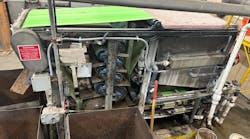With
population increases averaging about 18,000 per year, Gwinnett County in
Georgia is one of America’s fastest-growing areas, and treatment capacity needs
have been steadily increasing by two mgd per year since the early 1990s. Based
on these statistics, the DPU predicted that the seven existing facilities would
be over capacitated by the end of 2000.
Prior to
November 2000, the Gwinnett County Department of Public Utilities (DPU)
operated seven small- to mid-capacity wastewater treatment plants collectively
treating more than 48 million gallons per day (mgd).
In 1996, a
team of six engineering and construction firms consisting of Metcalf &
Eddy, Piedmont, Olsen & Hensley, Moreland Altobelli, Jordan Jones &
Golding, CH2MHill and Precision Planning formed the Gwinnett Water Partnership
of 2000. The partnership launched plans for a new 20-mgd wastewater treatment
plant that would have the potential for future capacity expansion. The design
included two enclosed anaerobic egg-shaped digesters for solids degradation,
making Gwinnett County the first in the southeast to employ this innovative new
trend in wastewater treatment.
The egg
digesters incorporate a circulation process in which the solids are removed
from the tank, sent through a heater and then returned to the tank for further
treatment, and it is here that Red Valve manual and control pinch valves are in
use for throttling control and maintenance isolation. The pinch valve’s
abrasion-resistant elastomer sleeve makes it useful for handling the thick
sludge present in this stage of the process, and the enclosed design keeps the
material contained. Several Red Valve Pinch Valves also control flow into the granular-activated
carbon adsorbers, an earlier stage of the process.
Even before
the facility went online in November 2000, the partnership was on site
designing a 40-mgd expansion. Start-up for the expansion is planned for 2002.
The plant’s
secondary clarifiers were built on the same plane as three raw-water storage
tanks, and the partnership was concerned that in the event of a tank overflow,
the untreated waste would contaminate water in the clarifying tanks. To prevent
the problem, a 48-inch Tideflex® InLine Check Valve from Red Valve was
installed to prevent unwanted flow into the clarifiers. Pressure on the outside
of the Tideflex Check Valve’s patented Duckbill® seals the valve drop-tight,
even around entrapped obstructions.
At the
Crooked Creek outfall where the re-use water from the Gwinnett plant currently
is being discharged, a multi-port diffuser was installed to better disperse the
final effluent and protect water quality in the Chattahoochee River downstream.
Designed by Montgomery Watson, the system includes 22 six-inch Red Valve
Tideflex Diffuser Valves. The variable-orifice design of the Tideflex Effluent
Diffuser increases the jet velocity of the discharge to enhance mixing and
dilution. The flattened-plume shape of the discharge stream created by the
Tideflex also aids in dispersion.
Tideflex
Effluent Diffusers offer the added benefits of a check valve by preventing
backflow into the outfall pipe. This stops the intrusion of sand, silt and mud
that can greatly reduce efficiency and eventually clog the system.
Additionally, expensive cleaning and/or flushing costs to remove buildup are
eliminated.
The
40-million-gallon-per-day expansion of the plant will discharge its effluent
into a brand new outfall at Gwinnett County’s Lake Lanier, where an even larger
Tideflex Diffuser System is being designed. The new system, which incorporates
a 96-foot multi-ported pipeline, will help to maintain the optimum water
quality that has already allowed Gwinnett to obtain a very generous water
permit. Gwinnett’s current permit allows the county not only to discharge 40
mgd, but also to retrieve that same amount to treat and dispense as finished
drinking water.

